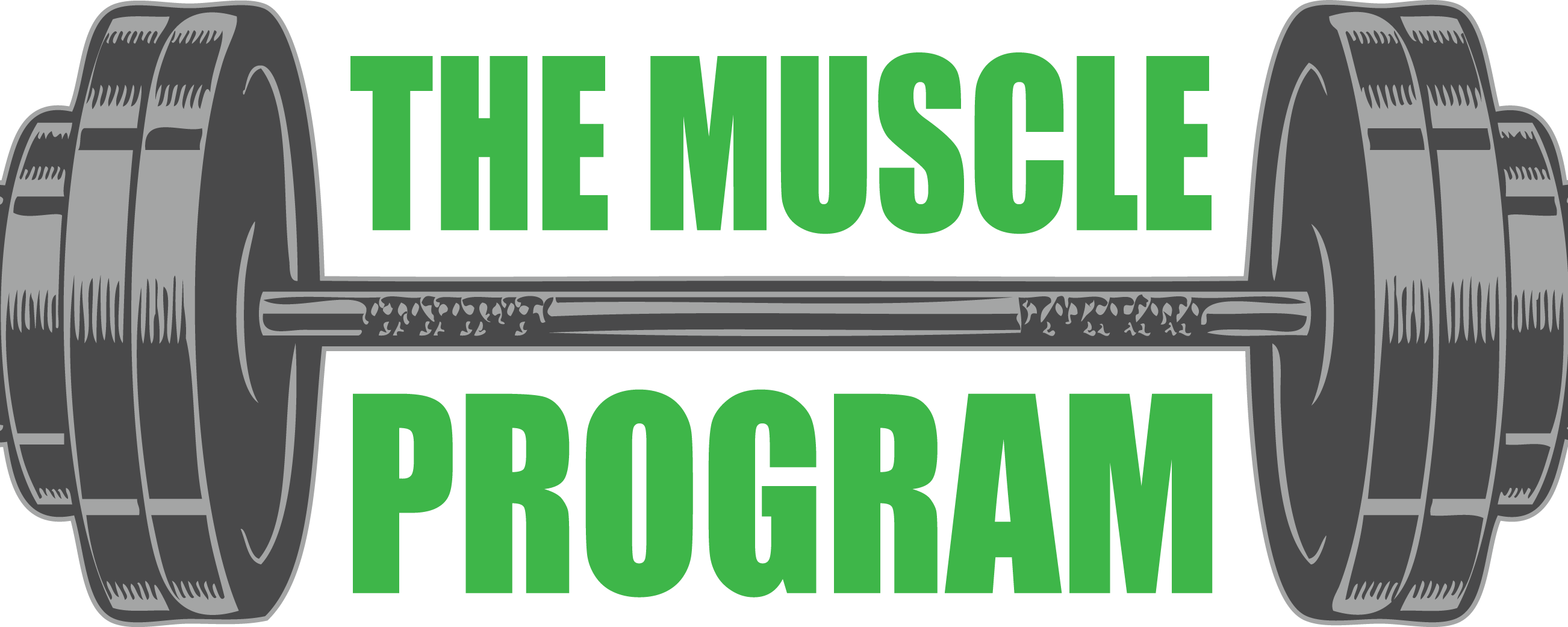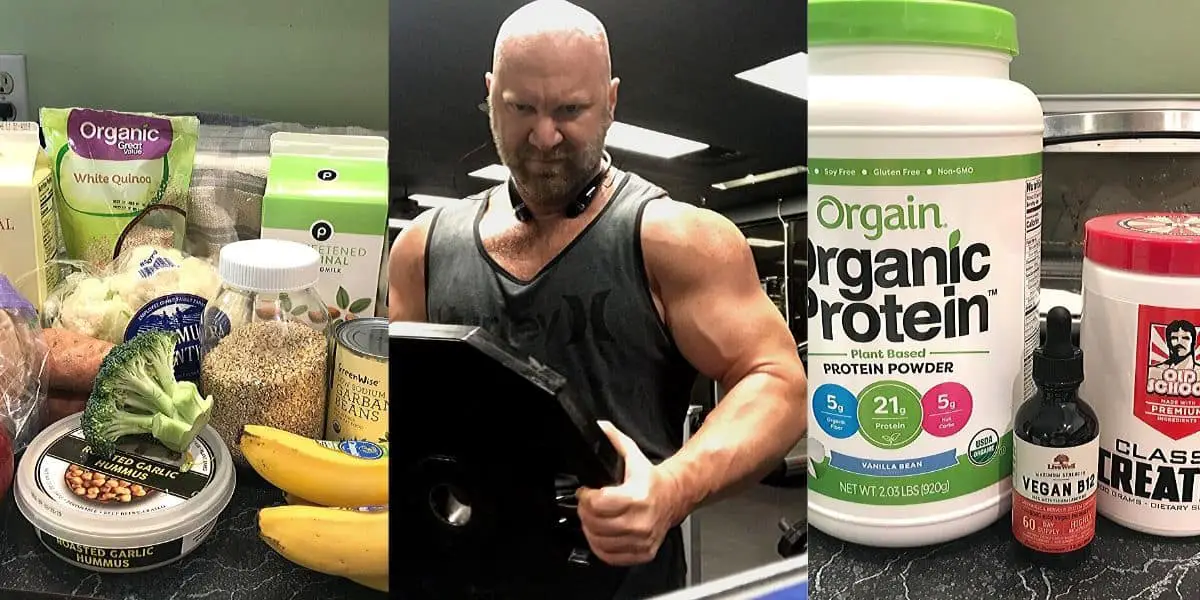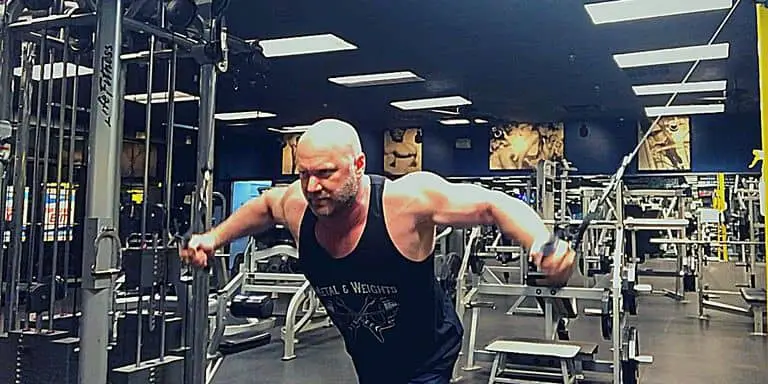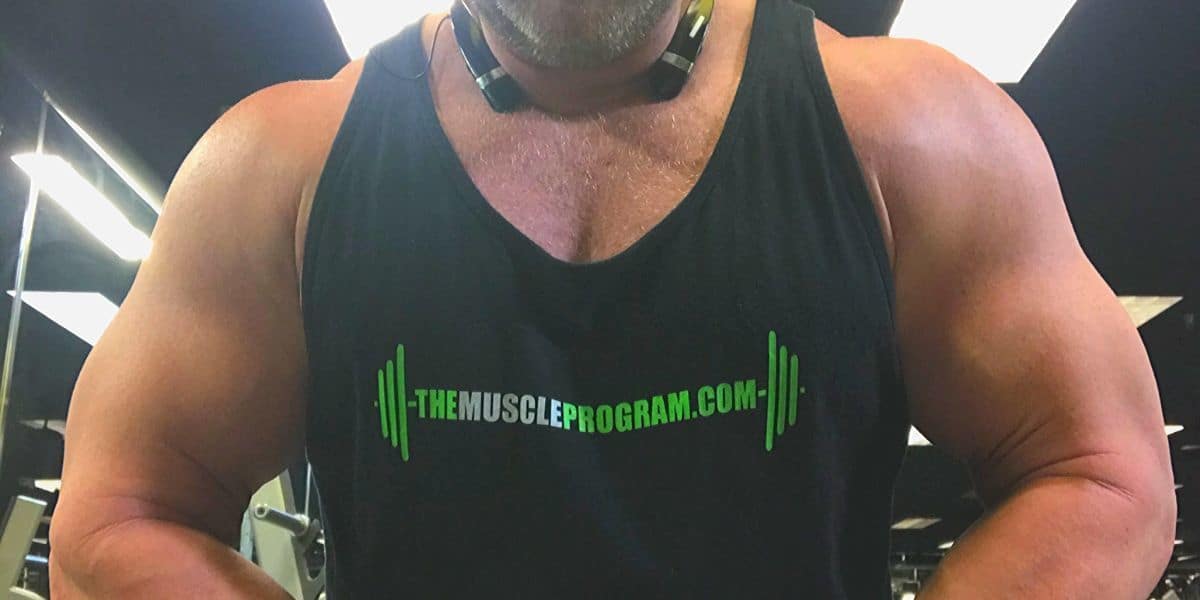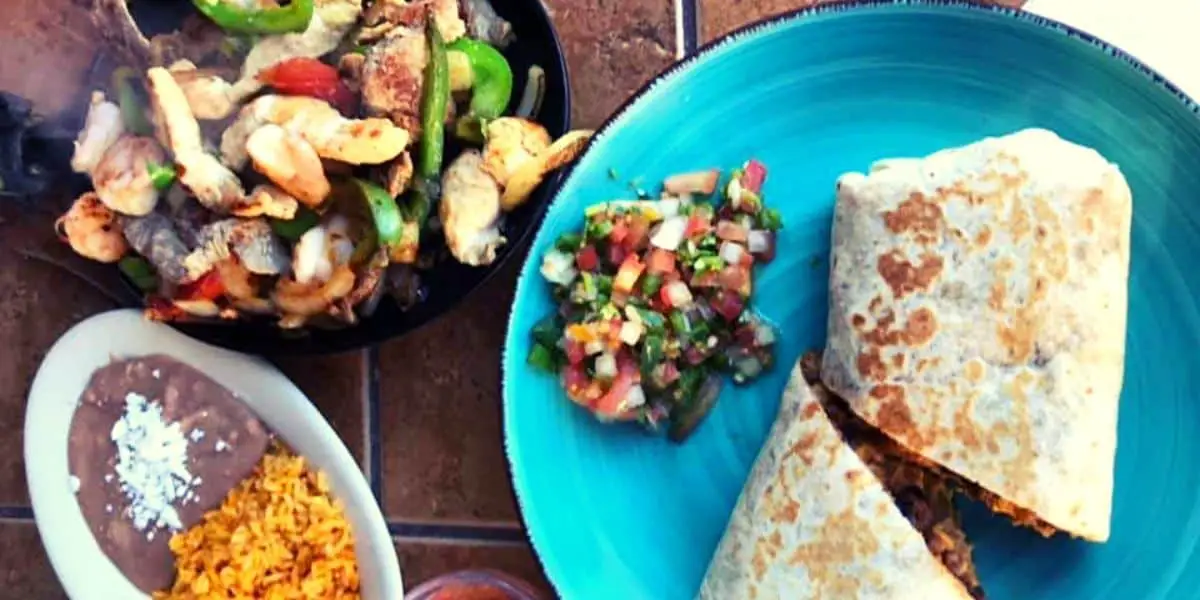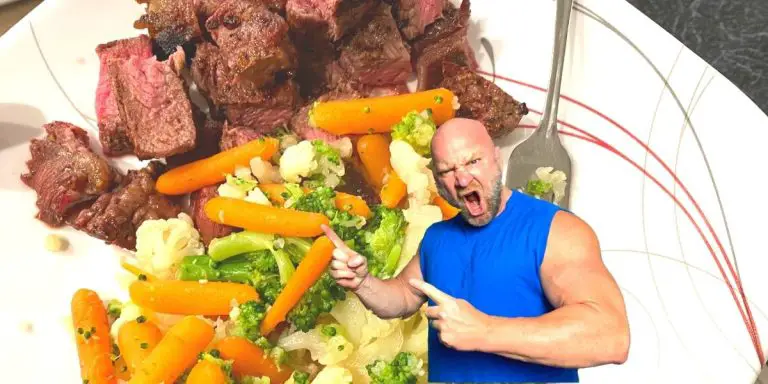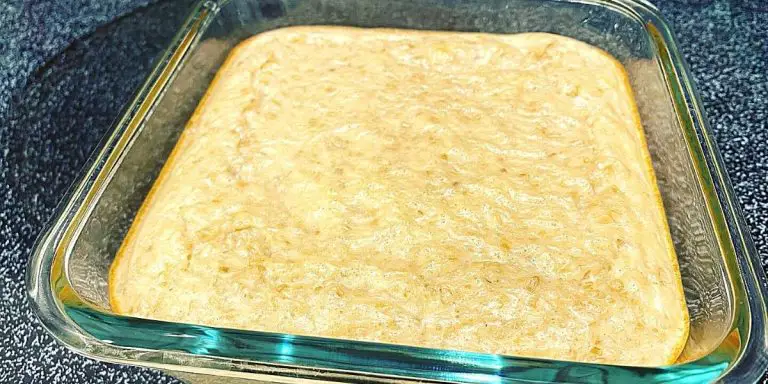How to Build Muscle on a Plant-Based Diet (Complete Guide Plan, Workout, and Supplements)
One of the most frequently asked questions when a bodybuilder is considering going vegan, or at least cutting meat and dairy, is…
Can you really build muscle on a plant-based diet? Yes, it’s possible but it’s not easy, and there are some caveats. And that’s what I’m going to address in this post.
There are a number of athletes and weightlifters who subscribe to a plant-based meal plan. But is it right for you?
You probably have some questions like…
- What about protein?
- Won’t I be eating too many carbs?
- Won’t I lose strength and mass?
- Will I be vitamin deficient?
I’m going to help answer these questions and more in my complete guide to plant-based muscle building. I’m also going to give you the potential drawbacks of going plant-based so that you can decide if it’s right for you.
Here’s what you’ll get in this post:
- Plant-based bodybuilding meal plan
- Plant-based foods high in protein
- 1-day plant-based meal plan
- 3-phase workout plan
- Supplements that are plant-based and vegan-friendly
IMPORTANT: This article is not saying that you should or should not go on a plant-based diet.
It’s simply a resource showing you how you can indeed build lean muscle on a plant-based meal plan.
And you’ll also get a complete workout and supplement plan in this post!
Plant-Based Bodybuilding Meal Plan
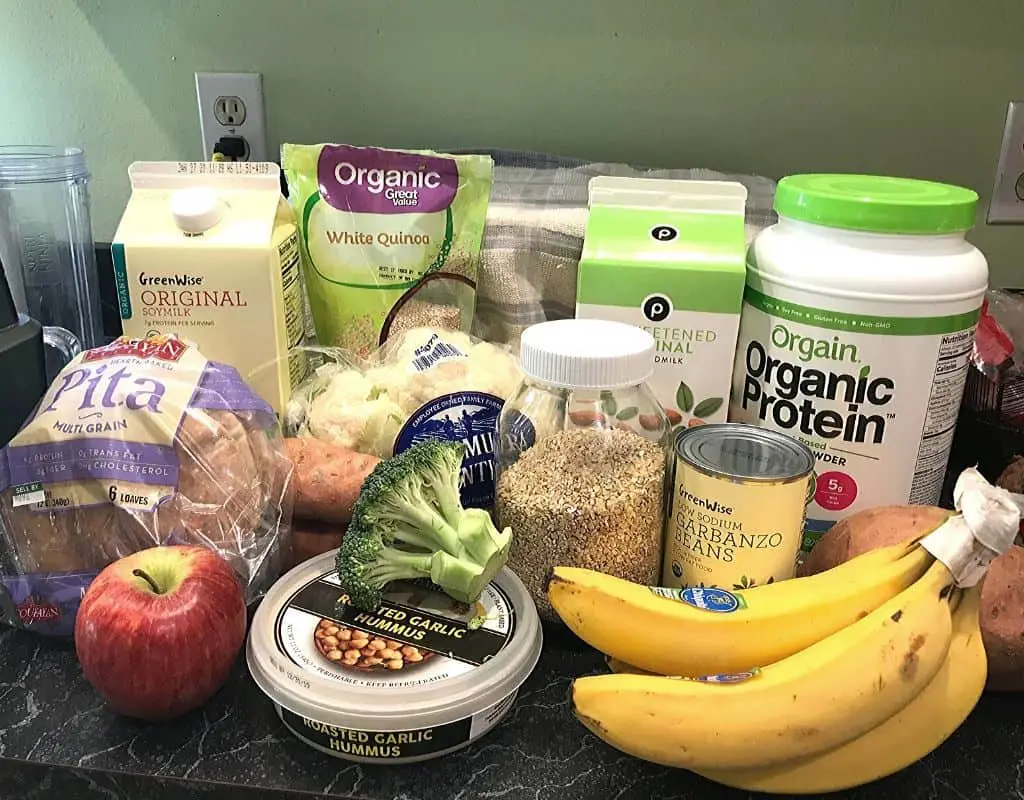
Let’s start with the core of building muscle on a plant-based diet – the meal plan.
In this section, I’m going to:
- Address your concerns about protein
- Give you a list of plant-based foods that are high (or at least moderate) protein foods
- Give a 1-day sample plant-based bodybuilding meal plan – you can use this as a helpful guide to creating your own
What About Protein?
The most common concern from bodybuilders and weightlifters is protein.
Yes, no matter what any of the so-called experts say, you DO need protein and amino acids to build muscle mass. You’re not going to build muscle from just eating carbs (fruits, vegetables, grains, etc.).
Although limiting protein intake is important, you should also realize that protein is essential to our bodies’ normal functions. It assists in synthesizing enzymes and hormones, maintaining fluid balance, and regulating such vital functions as building antibodies against infection, blood clotting, and scar formation.
‘Will Eating More Protein Help Your Body Gain Muscle Faster?’ by Miriam E. Nelse, Ph.D., on webmd.com
Protein is also a building block for our muscles, bones, cartilage, skin, hair, and blood.
Although plant-based protein sources may not seem ideal for bodybuilding, you do have some choices for moderate protein. And there are plenty of people who keep their strength and maintain their physique with these options.
No, you’re not going to get the same amount of protein in beans or tofu as you would a sirloin steak. But you can still get an adequate amount for building muscle.
So don’t stress out so much over protein. You’ll see in the foods and meal plan I give you below.
High Protein Plant-Based Foods
Here are a few of the plant-based foods with higher protein. The caveat is to get a decent amount of protein, you’ll need to double up on the servings of most of these foods below.
But keep in mind that you find that you don’t need as much protein as you think. You will, however, need to consume an adequate amount of calories for building muscle, and this is where many have trouble.
We’ll talk more about soon, but for now, here are plant-based foods with higher protein:
- Tempeh
- Tofu
- Seitan
- Lentils
- Chickpeas
- Nutritional yeast
- Quinoa
- Hempseed
These are also foods that you can eat if you’re a vegan, which Matt Beedle points out in his article ‘Vegan Bodybuilding Diet: The Ultimate Guide‘ on the vegan.io website:
This may not look like a ton of options (though there are more foods that contain moderate amounts of protein that you could double up on). Remember, you’ll often mix some of these foods together in the same meal.
For example, many will eat chickpeas with quinoa. 2 servings of each will give you about 24 grams of protein. Throw in some broccoli and cauliflower and you’ve got a vitamin-packed meal.
Tempeh and tofu will give you even more protein. And there are also plant-based, soy and pea protein powders. We’ll get more into those in the supplement section towards the end.
All that said, there’s no need to be overly concerned about your protein intake on a plant-based diet. Just make sure you’re getting enough overall calories to build muscle.
1-Day Plant-Based Meal Plan for Muscle Gains
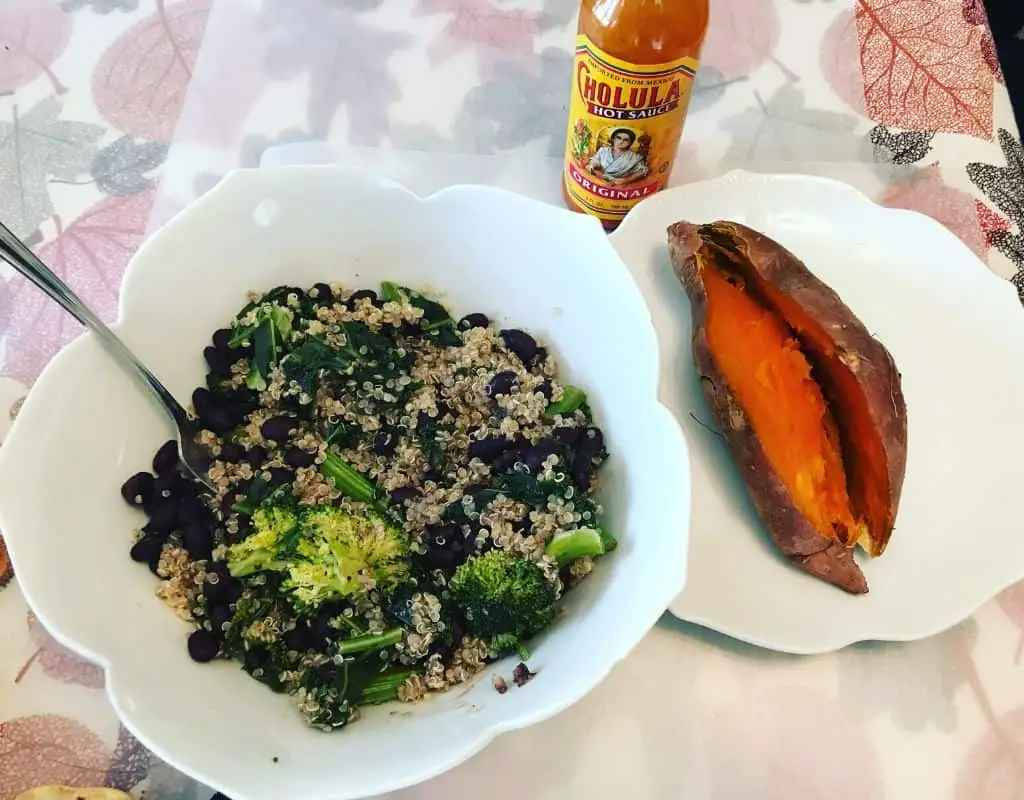
What does a day of meals look like for a plant-based or vegan bodybuilder? Below is a 1-day example of what you can eat.
This meal plan is based on 6 meals per day, spacing them out about every 3 hours. Yes, it’s the typical bodybuilding meal schedule. But hey, it works.
You still need to eat a lot of food, and eat frequent meals. It’s no different from a pro bodybuilders meal plan. It’s just that you’re not eating meat or dairy.
**I’m also laying this meal plan out based on an evening workout schedule to cater to the masses (no pun intended on the ‘masses!’). If you’re like me and train early mornings, you can move your pre and post-workout meals accordingly.
Meal 1: 6 AM
10 ounces of almond milk
30 grams of plant-based protein powder (like Orgain Plant-Based Protein)
1/3 cup of frozen blueberries
1 serving of frozen kale
1/2 serving of almond butter
*Having a shake or smoothie is a great way to get those nutrients in after fasting (aka sleeping) for 7-8 hours. I encourage you to do some sort of activity after this, such as Yoga, walking, or some dynamic stretching to start your day.
Meal 2: 9 AM
2 servings of oatmeal
1 banana
1/2 serving of almonds (halves)
*this can all be eaten together in the oatmeal
*Many on of plant-based diet consume eggs (this is a bit of a controversy in the vegan world). If that’s the case, then, by all means, add a couple of free-range eggs to this meal. And if you’re from the south, throw in some grits – they’re totally plant-based as they’re made from cornmeal!
Meal 3: 12 PM
2 servings of quinoa
2 servings of chickpeas
1 serving of broccoli
1 serving of cauliflower
*This is a common plant-based and vegan meal. And to be honest, it gets old, fast. One way to ‘spice it up’ is to add some organic hot sauce. In fact, you can add a different type of sauce each time and it will be like a different meal, keeping it from getting boring nad bland. Oh, and try salsa with it too!
Meal 4: 3:30 PM Pre-Workout
2-3 pieces of Ezekiel bread (or similar quality bread)
1 serving of natural peanut butter
1 banana
8 ounces of almond milk
20 grams of soy protein powder
*I’ve personally tested this meal and this will give you a ton of sustainable energy you need during your workout! If you’re not plant-based, you may switch the soy with whey protein. You’ll get the same effect.
Meal 5: 6:00 PM Post Workout
30-40 grams of plant-based protein powder
10 ounces of coconut milk
1 serving of spinach
1/2 cup of frozen dark berries
*This is the standard bodybuilder post-workout shake (often made with whey protein, but you’ll be making it with a plant-based powder). If you want more calories you can add a banana, some peanut or almond butter, or increase the serving of berries.
Meal 6: 7:30 PM
1 serving of tofu or tempeh
1 serving of beans or chickpeas
1 serving of green and red peppers
1 serving of broccoli
Coconut milk
Thai curry or any type or your choice of sauce
Optional: fish sauce (see note below)
*That last meal is one of my own plant-based Thai dishes. You can add fish sauce if you prefer. This would eliminate it from being vegan, but it’s part of most Thai meals. This is typically okay with plant-based diets. It’s your choice.
The awesome thing about being the plant-based diet is you’re going to be eating a ton of vitamins, minerals, and antioxidants by default from all of the fruits and vegetables you’ll be eating.
You don’t always get adequate amounts of those micronutrients with meat-based meals.
Many will move towards plant-based for this reason alone. It throws them into a world of eating things like green leafy vegetables that I may have not eaten much of before.
*If you’re looking for more meal plans and tips for building muscle on a meatless diet, read my posts below (this will open a new browser so that you don’t lose this page):
Vegetarian Mass Building Meal Plan
How to Build Muscle Mass on a Vegan Diet
3 Plant-Based Muscle Building Meal Plans
3-Phase Workout Plan
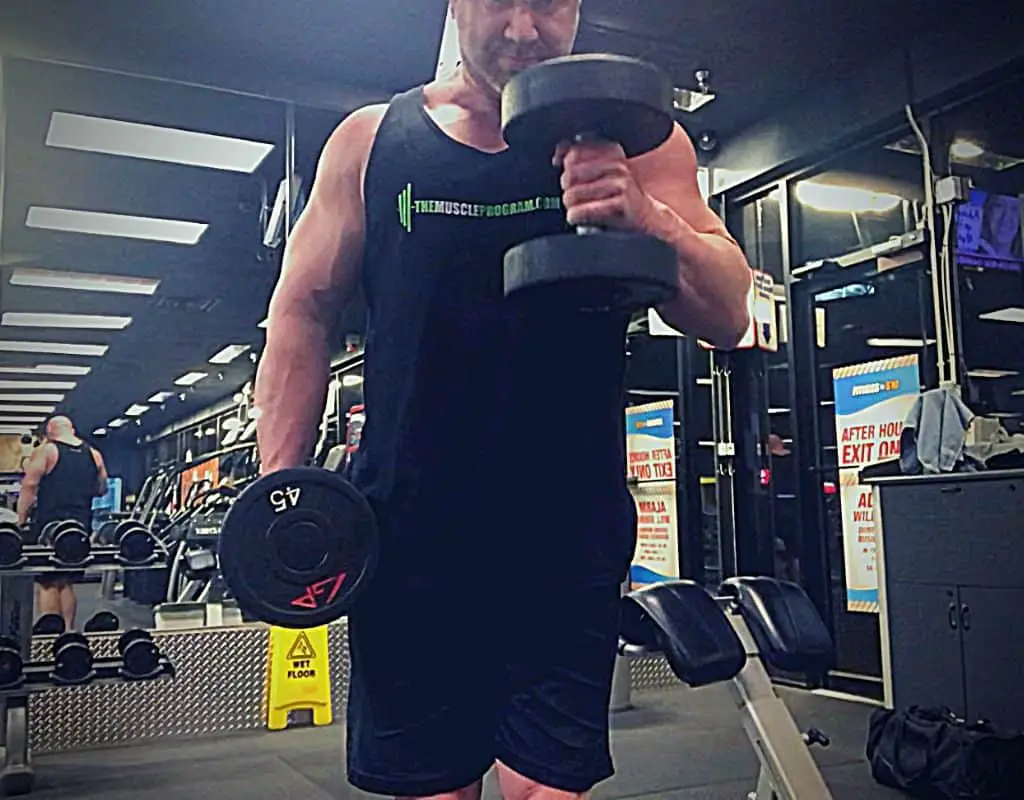
Here’s a secret I’ll let you in on. Whether you’re plant-based or vegan, you do not have to change your current workout routine. I know, I know…you’re like ‘Whew!’
There’s no reason for your workouts to be any different from what they are now. In other words, you’re still going to train to build muscle, gain size, and get jacked regardless of what you decide to eat.
You have to understand that building muscle requires two things:
- You have to train hard enough to break down the muscle so that it can repair itself, and grow back larger
- You have to eat enough quality calories to support muscle recovery and growth
When you understand how muscle is built, you will realize that animal products are not necessary, and they could actually have an adverse effect on your health.
‘How to Build Muscle on a Plant-Based Diet’ by Robert Cheeke, Oct 22, 2015, forksoverknives.com
Nutrition plays a huge role in whether or not you will build muscle. If you have been spinning your wheels when it comes to muscle gain, it is almost certainly related to your ratio of calories consumed to energy expended, factoring in the type of calories (whole plant foods or processed foods).
However, if you’re new to the plant-based world, or considering making the switch, you may notice some changes in your strength in the beginning once you change your diet. I did my best to address those above in the meal plan section, but making any drastic change can indeed impact your performance and strength in the gym, temporarily.
So I’m going to give you a 3-phase bodybuilding workout plan that will accommodate these changes you’ve made. I’ll also talk about some of the positive changes you should notice by sticking to the plant-based diet.
This is a 6-week program that will go like this:
- Weeks 1-2: Phase 1 – Deloading
- Weeks 3-4: Phase 2 – Adding more volume
- Weeks 5-6: Phase 3 – Ramping up the intensity
Phase 1 Workouts: Deloading
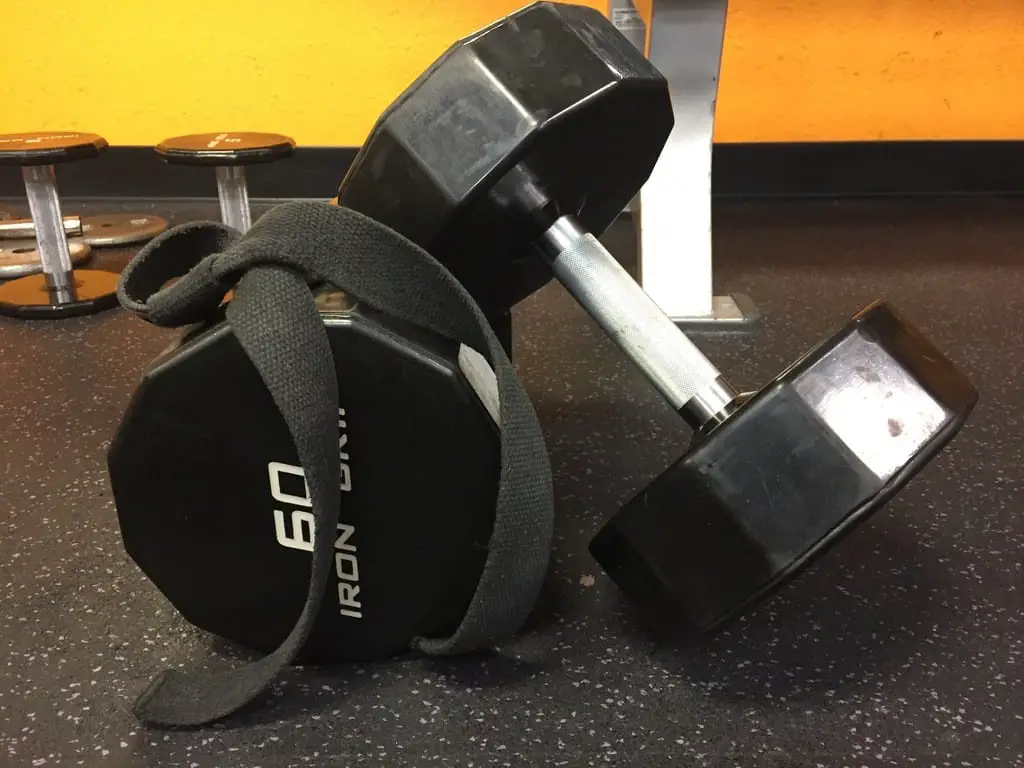
**If you’ve been plant-based or vegan for a while, you can skip to the Phase 2 workouts. Phase 1 is mainly for those who are new or considering making this transition.
Duration: 2 weeks
Training Days: 3
Training Schedule (example):
- Monday: Push day
- Tuesday: Rest
- Wednesday: Pull day
- Thursday: Rest
- Friday: Legs
- Saturday: Rest
- Sunday: Rest
I know the title of Phase 1 isn’t appealing (deloading). And deloading is something you normally at the end of an intense training program.
But hear me out because this tip may save you from an injury that could keep you out of the gym for weeks or more.
When you make any drastic change you have to be aware that your body and muscles may not be able to handle your normal workouts right away.
So if you’re new to this type of eating, I’m going to recommend backing off of the gym for a couple of weeks. I’m not saying don’t work out at all. But do more of a deload style of training.
You can read more about deloading in my post: Deload Workouts: Back Off to Gain More Muscle
This gives your body time to get accustomed to your new diet. And it’s mainly because you will more than likely make some diet mistakes during the first couple of weeks. Don’t beat yourself up though. It happens and you’ll get through it.
One big one is you may not eat enough or find yourself skipping meals. And of course, this will carry over to limitations to energy for your workouts, and most importantly, your ability to recover. That said, you may be more prone to injury.
So don’t sweat it, and back off a little for these first 2 weeks. Allow your body to get accustomed to your new way of eating.
Workout 1: Push Day
| Exercise | Sets x Reps |
| Bench Press | 3 x 8 |
| Incline Dumbbell Flyes | 3 x 10 |
| Seated Dumbbell Press | 3 x 10 |
| Cable Pressdowns | 3 x 10 |
Workout 2: Pull Day
| Exercise | Sets x Reps |
| Bent-Over Rows | 3 x 8 |
| Seated Rows | 3 x 10 |
| Lat Pulldowns | 3 x 10 |
| Preacher Curls | 3 x 10 |
Workout 3: Leg Day
| Exercise | Sets x Reps |
| Squats | 3 x 10 |
| Leg Press | 3 x 12 |
| Leg Extensions | 3 x 12 |
| Seated Leg Curls | 3 x 12 |
| Standing Calve Raises | 3 x 12 |
*You may recognize the Push, Pull, and Legs routine. This is also an awesome workout plan for building mass and strength I have a full program based on this type of routine here: Push-Pull-Legs Workout 6-Day Routine for Mass and Strength.
Phase 2 Workouts
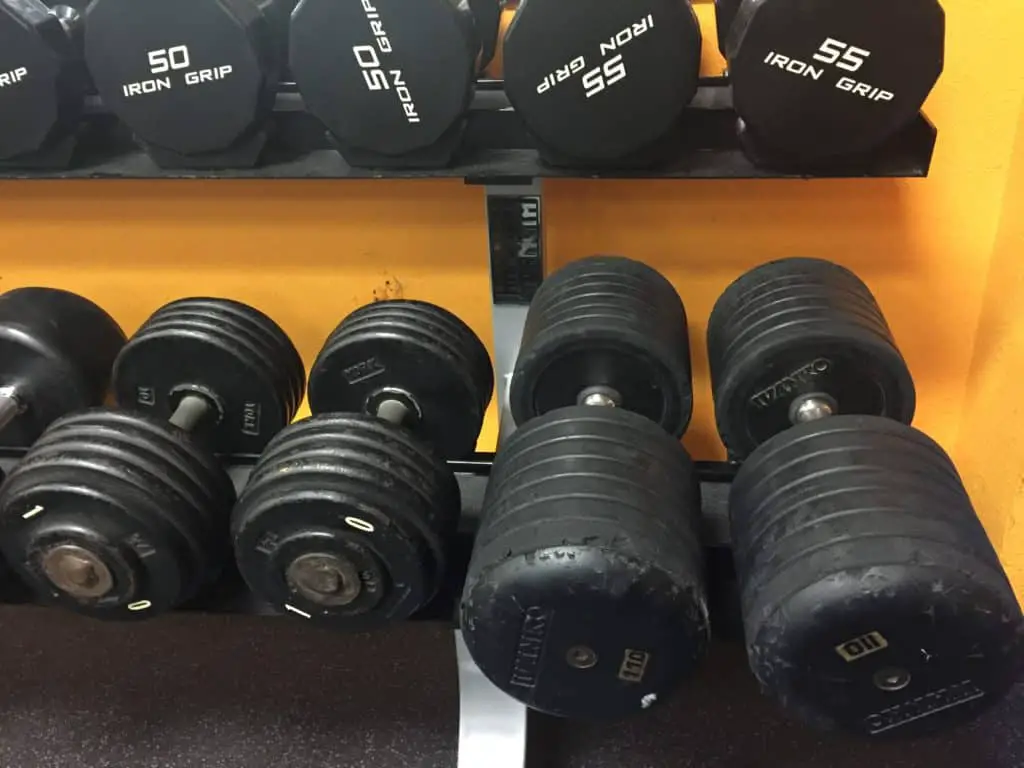
Duration: 2 weeks
Training Days: 5
Training Schedule (example):
- Monday: Back
- Tuesday: Legs – Quads
- Thursday: Chest and Biceps
- Thursday: Shoulders and Biceps
- Friday: Legs – Hamstrings
- Saturday: Rest
- Sunday: Rest
Now it’s time for Phase 2 of your 6-week program. You are either accustomed to your new plant-based diet, or you skipped Phase 1 because you had already made that transition.
Either way, the rest of this program is going to push you so get ready to make some serious muscle gains!
Your normal bodybuilding workout schedule is probably 4-5 days a week. You could make this a 4-day routine if you wanted to, but I’m a firm believer in training legs twice a week.
Workout 1: Back
| Exercise | Sets x Reps |
| Bent-Over Row | 4 x 8 |
| Seated Rows | 4 x 10 |
| Dumbbell Rows | 4 x 10 |
| Lat Pulldowns | 4 x 10 |
| Cable Pullovers | 3 x 12 |
Workout 2: Legs – Quads
| Exercise | Sets x Reps |
| Squats | 4 x 8 |
| Leg Press | 4 x 15 |
| Single-Leg Extensions | 4 x 12 |
| Hack Squats | 3 x 12 |
| Seated Calve Raises | 7 x 12 |
Workout 3: Chest and Biceps
| Exercise | Sets x Reps |
| Incline Bench Press | 4 x 8 |
| Dumbbell Press | 4 x 10 |
| Cable Flyes | 4 x 10 |
| Dumbbell Hammer Curls | 3 x 8 |
| EZ Bar Curls | 3 x 10 |
Workout 4: Shoulders and Triceps
| Exercise | Sets x Reps |
| Seated Dumbbell Press | 4 x 10 |
| Lateral Raises | 4 x 10 |
| Bent-Over Raises | 4 x 10 |
| Overhead Dumbbell Extension | 3 x 8 |
| Single-Cable Pressdowns | 3 x 8 |
Workout 5: Legs – Hamstrings
| Exercise | Sets x Reps |
| Stiff-Leg Deadlifts | 4 x 10 |
| Lying Leg Curls | 4 x 10 |
| Close-Stance Leg Press | 4 x 12 |
| Seated Calve Raises | 7 x 12 |
Phase 3 Workouts
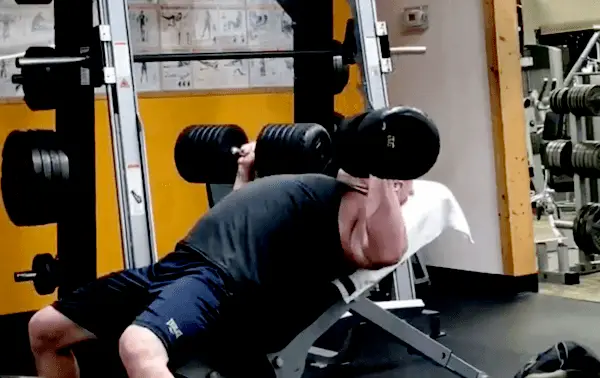
Duration: 2 weeks
Training Days: 6
Training Schedule (example):
- Monday: Push day
- Tuesday: Rest
- Wednesday: Pull day
- Thursday: Rest
- Friday: Legs
- Saturday: Rest
- Sunday: Rest
In Phase 3, your workouts are going to get more brutal. And you should be completely comfortable building muscle on a plant-based diet.
It’s time for a demanding bodybuilding routine that will put all those plants you’re eating to use and build some ripped muscle.
Okay, so that’s sounded a bit cheesy, but really, this is going to be an awesome routine for you!
You’ll be training 6 days a week. The purpose s to essentially train each muscle twice a week (shoulders are only once you but you hit them indirectly when training any upper body muscle).
Another benefit of this 6-day a week routine is that you’ll be working your muscles from all angles. For example, the exercises you do for back on Friday will be different from the ones you did on Monday. This will be the case for most body parts.
This plan is going to be exciting and will help you build an amazing physique.
Workout 1: Back
| Exercise | Sets x Reps |
| Barbell Rows | 4 x 6 |
| Dumbbell Rows | 4 x 8 |
| T-Bar Rows | 4 x 10 |
| Seated Rows | 4 x 10 |
| Cable Pullovers | 3 x 12 |
Workout 2: Legs
| Exercise | Sets x Reps |
| Leg Extensions | 5 x 15 |
| Squats | 4 x 8 |
| Leg Press | 5 x 15 |
| Single-Leg Extensions | 7 x 15 |
| Standing Calve Raises | 7 x 15 |
*You can superset those final 2 legs exercises, single-leg extensions and seated calve raises.
Workout 3: Chest and Biceps
| Exercise | Sets x Reps |
| Bench Press | 4 x 6 |
| Incline Dumbbell Press | 4 x 8 |
| Dumbbell Flyes | 4 x 10 |
| EZ Bar Curls | 3 x 8 |
| Dumbbell Hammer Curls | 3 x 10 |
Workout 4: Shoulders and Triceps
| Exercise | Sets x Reps |
| Arnold Press (seated dumbbell) | 4 x 10 |
| Lateral Raises | 4 x 10 |
| Bent-Over Raises | 4 x 10 |
| Cable Pressdowns | 3 x 8 |
| Overhead Dumbbell Extensions | 3 x 10 |
Workout 5: Legs and Back
| Exercise | Sets x Reps |
| Stiff-Leg Deadlifts | 4 x 10 |
| Close-Stance Leg Press | 4 x 15 |
| Seated or Lying Leg Curls | 4 x 10 |
| Reverse Grip Barbell Rows | 4 x 10 |
| Lat Pulldowns | 4 x 12 |
Workouts 6: Chest and Arms
| Exercise | Sets x Reps |
| Incline Bench Press | 4 x 10 |
| Cable Flyes | 4 x 12 |
| Close-Grip Bench | 3 x 10 |
| Preacher Curls | 3 x 10 |
| Rope Pressdowns | 3 x 10 |
| Alternate Dumbbell Curls | 3 x 10 |
*I have another 6-day bodybuilding workout routine in my post: 6-Day Bro Split Bodybuilding Routine. So try that after you go through this routine!
Plant-Based Supplements for Muscle Gain
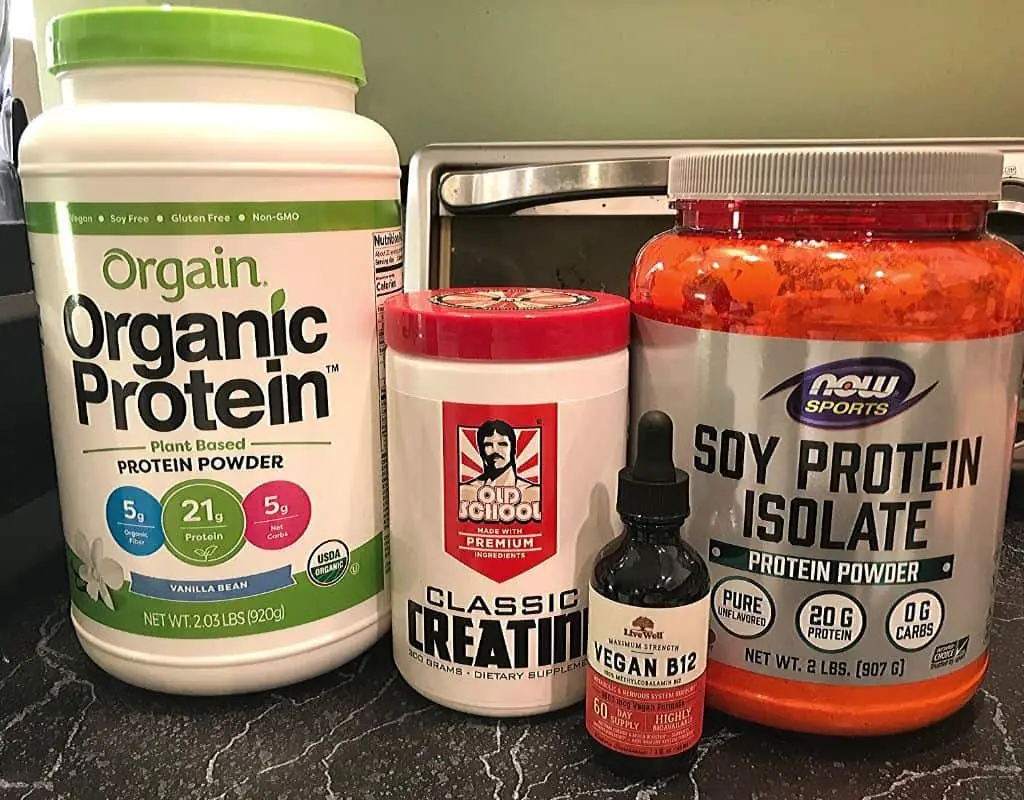
If you’re like me, you may think that you’re able to continue taking all of your supplements when you go plant-based. But if you read the labels closely and dig into how they are manufactured, you’ll soon be ditching most of the supplements that are sitting on top of your refrigerator (because you know, that’s where we keep our supplements…on top of the fridge!).
Here’s the good news. You don’t need half of the crap you’re taking anyway. Trust me on this one. Most everything you’re taking is a complete waste of money and it’s not really doing anything for you.
This is actually true whether you’re plant-based or not. And I’ll tell you why…
Most of the true vitamins, minerals, antioxidants, and such are in the foods you’re eating in your new plant-based diet. But even if you’re eating meat and dairy, you should also be including fruits and veggies.
Back to supplements, there are a few supplements you’ll want to consider taking to build more muscle on a plant-based diet. And there may also be some deficiencies you need to think about since you’re not eating meat. I’ll cover all of that.
Here are 3 plant-based-friendly (and vegan-friendly) bodybuilding supplements you may want to start taking (these are links to purchase to Amazon, in which I do get rewarded when your purchase through my link – it’s a great way to support this website, and I appreciate that):
- Protein powder (not whey)
- Creatine (there are vegan-friendly creatine supplements available)
- Vitamin B12
Plant-Based (Non-Dairy) Protein Powder
One of the most challenging things about being a vegan bodybuilder is switching from whey to plant-based protein powder. Whey protein has a full amino acid profile and fast-digesting, making it perfect for building muscle, and especially for post-workout shakes.
Fortunately, there are other options for protein powder. So you can still have your post-workout shake (I’ll even give you a recipe below!).
There are 3 main types of vegan-friendly protein powders:
- Plant-based protein
- Soy protein (I’m personally on the fence about soy protein; it can have an impact on your stomach)
- Pea protein
One thing I need to point out is to make sure you read the labels as some of the powders may have more carbs than what you’re used to. So that will be important if you’re counting macros.
And remember, your macronutrient ratios are going to naturally shift to more carbs, so make sure you’re adding plenty of fruit to your post-workout shakes. This is the time where you can eat simple sugars to replenish your glycogen levels – you’ll see an example of this below…
*My personal favorite non-whey protein is Orgain Organic Plant-Based Protein Powder – Vanilla Bean. It’s not the greatest tasting, but bearable and really good when you blend it with other foods, which I’ll share below.
Plant-Based Post Workout Shake Recipe
- 10 ounces of almond milk
- 20-30 grams of plant-based protein powder
- 1 cup of frozen blueberries
- 1 banana
- 1 serving of frozen kale
- 1/2 serving of natural peanut butter
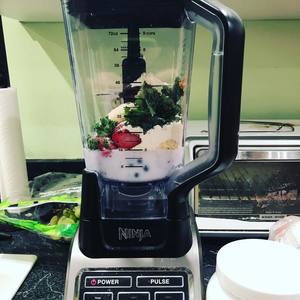
*As we discussed in the beginning with eggs, some plant-based lovers may still incorporate some dairy products in their diet. This is one of the core differences between plant-based vs. vegan.
If this is you, then you may decide to continue using whey protein powder. Just make sure you get it from a reputable brand. Here are 2 of my favorites in a post: My Top 2 Whey Protein Powders with Protein Shake Recipes
Vegan-Friendly Creatine
The absolute best muscle building supplement has been the most effective supplement for decades and that is creatine. And it’s great if you’re on a budget because it’s super cheap.
Here’s the problem though. Many creatine monohydrate supplements from made from animal byproducts per One Green Plant’s article ‘Do Plant-Based Athletes Need Creatine?’ by Jen Edith.
Because creatine is such an awesome and undeniable muscle builder, there are several manufacturers that have vegan-friendly creatine supplements. So I ‘strongly’ encourage bodybuilders and athletes to take a creatine supplement when building muscle is the goal.
Here are a couple of these creatine monohydrate supplements from reputable brands:
Old School Labs Classic Creatine
Bulk Supplements Creatine Monohydrate
Again, if you’re plant-based and not vegan, it may not matter what type of creatine you take. This is a personal choice.
The quality of creatine should be the same, whether vegan-friendly or not. Just make sure your creatine supplement is from a reputable manufacturer, such as the ones listed above.
Vitamin B12
There’s one essential vitamin you may indeed lack on a plant-based diet that you would normally get from eating meat. It’s vitamin B12.
According to the U.S. National Library of Medicine (on their website medlineplus.gov), vitamin B12 is an essential vitamin and important for metabolism, the formation of red blood cells, and helps maintain your central nervous system.
So this isn’t something you want to be deficient of. The good thing is there are countless vitamin B12 supplements. Just make sure you go with a reputable product and one that is easily absorbed.
*The best time to take your vitamin B12 supplement is before your workouts. I take Live Well Vegan Vitamin B12 (sublingual liquid drops) before I go to the gym. This gives you a nice energy boost!
What About Multivitamins?
Some opt to take a multivitamin. But that may not be necessary because of your vitamin-rich diet.
However, if you want to take something just make sure you cover your basis, try Naturelo Wholefood Daily Vitamin. These are vegan-friendly made with vegetarian capsules and non-GMO:
Naturelo Wholefood Daily Vitamin – for Men
Naturelo Wholefood Daily Vitamin – for Women
What About Calcium?
Some may also be concerned about calcium deficiency. That can be easily taken care through drinking certain brands of almond milk. Now, almond milk does not naturally contain more calcium than regualr milk, per Duke Diet & Fitness Center’s article ‘Dairy Milk vs Almond Milk: Which is Better?‘
However, many brands include a calcium boost in their almond milk. So make sure you read the labels carefully to make sure your almond milk contains adequate calcium.
Other Muscle Building Supplements
The one core muscle building supplement not listed is BCAAs (branched-chain amino acids). Like with many bodybuilding supplements, the majority of BCAA products are derived from animals.
That’s okay because there are some highly-rated (according to the Amazon reviews) vegan-friendly BCAAs out there. Here are a couple of options:
Truth Vegan BCAA Powder – Energy and Muscle Building
Genius BCAA Powder – Muscle Recovery and Vegan Energy
As mentioned several times before, some plant-based dieters are not as concerned about these types of nuances and will take regular BCAAs and supplements.
Either way, BCAAs can be extremely beneficial to building muscle. And a typical plant-based or vegan diet lacks BCAAs.
**If you want a high quality BCAA supplement that isn’t necessarily vegan-friendly, check out my review on my favorite BCAA here: Scivation Xtend BCAAs for Muscle Growrth and Recovery.
Will You Build More Muscle on a Plant-Based or Vegan Diet?
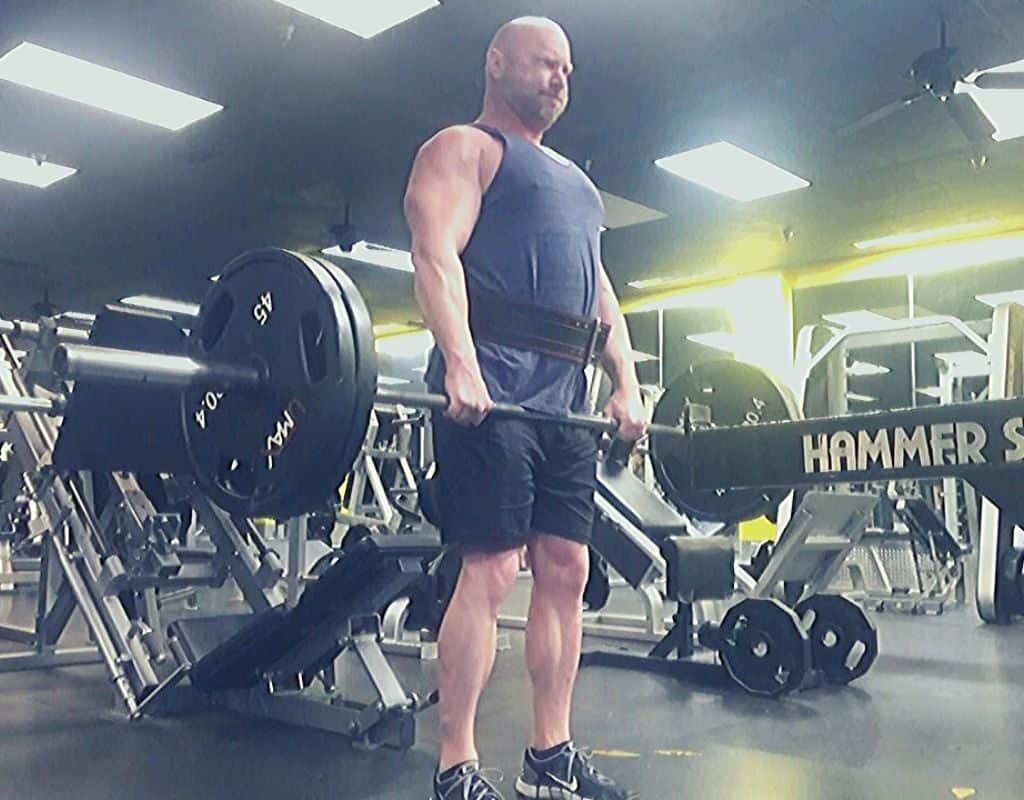
The likelihood of you building more muscle on a plant-based diet versus a regular diet with is slim. I know that’s not what you want to hear. And of course, many will challenge this statement.
But that doesn’t mean you can’t build muscle on a plant-based meal plan. And who knows, you may end up building more muscle as a vegan, or eating plant-based foods than you would if you didn’t make this change.
Here’s something you must realize, though. Going plant-based is not a decision that’s based on muscle gains. In fact, it has nothing to do with packing on muscle.
People switch to plant-based or vegan meal plans for health, environmental and other reasons. But not solely to increase muscle size or strength.
If you’re interested in non-plant-based meal plans, read one of my most popular posts Meal Plans for Mass and Strength Gains.
Of course, that doesn’t mean you cannot build muscle on a plant-based diet. I just gave you ana entire guide that proves you can! But understand that yes, your gains may be a bit limited compared to a meat-based diet.
Whatever you decide, you have to be comfortable with your decision and be honest with yourself on the reasons why you’re following a specific meal plan. Second, to that, make sure you’re busting your butt in the gym and hold nothing back! You will make gains!
Excuses Don’t Build Muscle,
Jason
